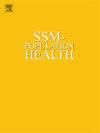The biological consequences of grandparental death for children: An analysis of telomere length
IF 3.1
2区 医学
Q1 PUBLIC, ENVIRONMENTAL & OCCUPATIONAL HEALTH
引用次数: 0
Abstract
Increasingly, health scholars acknowledge bereavement as a determinant of population health. Some research suggests that childhood health is especially affected by the deaths of family members. Although most research has focused on losing a parent or sibling in childhood, more recently, scholarship has established grandparental death as a source of poor mental health. We know less, however, about whether grandparental death affects children biologically, potentially imprinting them in a way that is consequential for their physical health and development. In this study, we offer the first analysis of the association between grandparental loss and U.S. children's telomere length—a common biomarker that reflects cumulative stress exposure. We use data from the Future of Families and Child Wellbeing Study to study grandparental death and children's telomere length at around age 9. Boys' telomere length is not associated with grandparental death; however, girls, and in particular girls who did not co-reside with their grandmother around age 5, had shorter telomere lengths following the death of their grandmother compared to girls whose grandmothers were still alive. Specifically, a non-co-resident grandmother's recent death corresponds with 11 % shorter telomeres among girls (p < 0.001), which persists net of covariates. This study demonstrates that grandparental death is a unique health risk factor for children, emphasizing the need to consider grandparental death as an underappreciated source of childhood health disparities.
祖父母死亡对儿童的生物学影响:端粒长度分析
越来越多的健康学者承认丧亲之痛是人口健康的决定因素。一些研究表明,儿童健康尤其受到家庭成员死亡的影响。虽然大多数研究都集中在童年时失去父母或兄弟姐妹,但最近,学术研究已经确定,祖父母去世是心理健康状况不佳的一个原因。然而,我们对祖父母的死亡是否会对孩子产生生物学上的影响知之甚少,是否会以一种对他们的身体健康和发展产生影响的方式给他们留下印记。在这项研究中,我们首次分析了祖父母丧失与美国儿童端粒长度之间的关系——端粒长度是一种反映累积压力暴露的常见生物标志物。我们使用来自未来家庭和儿童健康研究的数据来研究祖父母的死亡和9岁左右儿童的端粒长度。男孩端粒长度与祖父母死亡无关;然而,女孩,特别是那些在5岁左右没有和祖母住在一起的女孩,在祖母去世后的端粒长度比祖母还活着的女孩要短。具体来说,一位非共同居民的祖母最近去世,与女孩的端粒缩短11%相对应(p <;0.001),这在协变量中仍然存在。这项研究表明,祖父母死亡是儿童的一个独特的健康风险因素,强调需要考虑祖父母死亡作为儿童健康差异的一个未被充分认识的来源。
本文章由计算机程序翻译,如有差异,请以英文原文为准。
求助全文
约1分钟内获得全文
求助全文
来源期刊

Ssm-Population Health
PUBLIC, ENVIRONMENTAL & OCCUPATIONAL HEALTH-
CiteScore
6.50
自引率
2.10%
发文量
298
审稿时长
101 days
期刊介绍:
SSM - Population Health. The new online only, open access, peer reviewed journal in all areas relating Social Science research to population health. SSM - Population Health shares the same Editors-in Chief and general approach to manuscripts as its sister journal, Social Science & Medicine. The journal takes a broad approach to the field especially welcoming interdisciplinary papers from across the Social Sciences and allied areas. SSM - Population Health offers an alternative outlet for work which might not be considered, or is classed as ''out of scope'' elsewhere, and prioritizes fast peer review and publication to the benefit of authors and readers. The journal welcomes all types of paper from traditional primary research articles, replication studies, short communications, methodological studies, instrument validation, opinion pieces, literature reviews, etc. SSM - Population Health also offers the opportunity to publish special issues or sections to reflect current interest and research in topical or developing areas. The journal fully supports authors wanting to present their research in an innovative fashion though the use of multimedia formats.
 求助内容:
求助内容: 应助结果提醒方式:
应助结果提醒方式:


